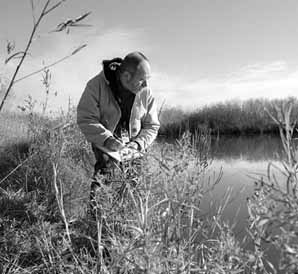 |
|
Frogs Come-A-Countin': Survey offers environmental clues along with numbers by Rod Walton, Fermilab Facilities Engineering Services Section
 Walking around the Fermilab site in the evening in early Spring, you may have heard the chorus of a huge number of spring peepers or chorus frogs. Later, on a warm summer night, a fat bullfrog may have serenaded you with his deep "jug-a-rum," or his ugly cousin, the American toad with his long and loud trill. (Yes, "his" is the correct pronoun; only males call). Frogs and toads are ubiquitous at Fermilab, owing to our abundant ponds and wetland areas, but they are not particularly noticeable except through their calls. As a matter of fact, they aren't much more visible to prospective mates, and that's why they call in the first place. Gathering in lakes, ponds and wetlands in the spring and early summer, males call relentlessly to attract females.
Walking around the Fermilab site in the evening in early Spring, you may have heard the chorus of a huge number of spring peepers or chorus frogs. Later, on a warm summer night, a fat bullfrog may have serenaded you with his deep "jug-a-rum," or his ugly cousin, the American toad with his long and loud trill. (Yes, "his" is the correct pronoun; only males call). Frogs and toads are ubiquitous at Fermilab, owing to our abundant ponds and wetland areas, but they are not particularly noticeable except through their calls. As a matter of fact, they aren't much more visible to prospective mates, and that's why they call in the first place. Gathering in lakes, ponds and wetlands in the spring and early summer, males call relentlessly to attract females.
An unexpected consequence of this behavior is the attraction of large numbers of amateur herpetologists, interested in documenting how many and what kinds of frogs there are in an area. Chicago Wilderness, a regional consortium of scientific and land management organizations in northeastern Illinois, has been conducting a survey of calling frogs in our area for the past two years. A calling frog survey is a rather simple endeavor. Volunteer participants only need to be able to identify the calls of the eleven or so species of frogs and toads that occur in the region, then go out on certain nights to listen for frogs and record their observations. Aside from the naturalist's inborn curiosity, this kind of basic data is crucial as a long term, regional baseline of frog distribution and abundance. Frogs are particularly susceptible to environmental stresses, because they typically live part of their lives in aquatic, and part in terrestrial habitats. Additionally, frogs exchange gases directly with the air through their skin, so they tend to have a maximum amount of surface area exposed to any contaminants. Beginning in the early 1980's, biologists realized that amphibians such as frogs are extremely sensitive to environmental stresses. Declines in amphibian numbers and increases in deformed anatomy have led scientists to investigate the role of habitat loss, increased ultraviolet radiation (due to ozone depletion), and chemical pollution in these important changes. For example, Blanchard's cricket frog was the most common amphibian in Illinois in the 1960's. However, today it has nearly disappeared from the northern third of Illinois, for as yet unknown reasons. To address the needs of amphibians in our region, we first must know their distribution as the first step in assessing the population status of a given species. Of the eleven species that reside in the Chicago Wilderness area, only eight are commonly found at Fermilab. During three specified periods from Spring into late summer, volunteers pack up clipboards, flashlights and thermometers and head to listening spots to hear how many and what species of frogs are there. Some of the areas are temporary vernal pools in the woods, while others are permanent large water bodies, like Logo Lake in the middle of the Tevatron ring. Air temperature, wind, and cloud cover are all factors that can affect the calling frogs, so careful observations are made at each spot, then qualitative estimates of the numbers of individuals and species are recorded over a 5 minute period. These data are then entered into the Chicago Wilderness Herpetological Atlas, which will show which species occur where in the region. This information is passed on to landowners and appropriate governmental agencies, such as the county forest preserve district, to aid in land management. Fermilab is an almost perfect spot to conduct frog surveys because of its size and the nearly natural setting. Frog populations on this site are not subjected to many of the stresses that are present in more congested urban and suburban settings, even in forest preserves and parks. One way of saying this is that the frog populations here are situated in a more nearly functional ecosystem, complete with a suite of predators, many types of acceptable habitat, and abundant food. Volunteering to help monitor Fermilab's frog population for Chicago Wilderness is easy. Contact Rod Walton at extension 2565 or rwalton@fnal.gov and sign up! Then, next Spring, after a short training course, you can begin collecting data. On the Web: Chicago Wilderness http://www.chicagowilderness.org Frogs of Fermilab http://www-ed.fnal.gov/projects/frogs/ |
| last modified 11/9/2001 by C. Hebert email Fermilab |
FRLsDFx9eyfrPXgV